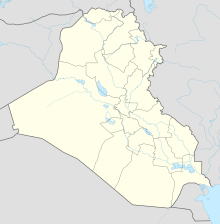Tappa Gaura
Coordinates: 36 ° 30 ′ 46 ″ N , 43 ° 14 ′ 5 ″ E
Tappa Gaura or Tepe Gawra (German: Big Hill ) is a settlement hill in Iraq , about four kilometers east of Chorsabad in what is now the Iraqi province of Ninawa . The Tell was settled from the Ceramic Neolithic to the Bronze Age.
Tappa Gaura was discovered by Ephraim Avigdor Speiser in 1927 and excavated by American archaeologists from the University of Pennsylvania between 1930 and 1937 . From 1930 to 1932 and 1936 to 1937 excavations took place under the direction of Speiser, in the intervening period under Charles Bache . There was evidence of an almost complete settlement from the late 6th millennium BC. . BC to the middle of the second millennium BC. Proven. From the 6th millennium remnants originate a narrow village settlement with simple adobe buildings and polychrome ceramics of Tell Halaf named Halaf period .
In layer XI-A, the foundations of a large round house were exposed. This so-called Round House was centrally located on Tell and was the largest building there from the transition period from the late Ubaid period to the early Uruk period , around 4000 BC. Particularly noteworthy objects come from graves of the Uruk period. These include pearls made of lapis lazuli , gold jewelry, carefully crafted stone vessels made of marble and serpentine, and combs made of ivory . A dog grave in connection with a human burial is known from Tappa Gaura .
In the middle of the 4th millennium BC The village development was reduced and after a hiatus (period of time without archaeological finds) three special buildings in a central hall construction were built on the hill of ruins. They have a niche and pillar decoration typical of later temples, but no altar has been exposed that would confirm this assignment. All three buildings are in an open space.
More recent finds include stamp seals with animal motifs from the 3rd millennium BC. Chr. And the foundations of temples from the Assyrian period.
literature
- Pascal Butterlin (Ed.): A propos de Tepe Gawra, le monde proto-urbain de Mésopotamie - About Tepe Gawra: a proto-urban world in Mesopotamia , Brepols Publishers, 2009, ISBN 978-2-503-53002-4 .
- Mitchell S. Rothman: Tepe Gawra: The Evolution of a Small, Prehistoric Center in Northern Iraq . University of Pennsylvania Museum Publications, 2001, ISBN 978-0-924171-89-5 Book Description .
- Ephraim Avigdor Speiser: Excavations at Tepe Gawra I. University of Pennsylvania Press, Philadelphia 1935, ISBN 9991553401
- Arthur J. Tobler: Excavations at Tepe Gawra II. Joint Expedition of the Baghdad School and the University Museum to Mesopotamia. 2 vols. University of Pennsylvania Press, Philadelphia 1950.
- Ernst Heinrich : Buildings in Old Sumerian visual art . Harrassowitz, Wiesbaden 1957, p. 48 ff.
Web links
- Early Copper Metallurgy at Teppe Gawra
- Tepe Gawra , MIT Libraries
Individual evidence
- ↑ Attempted reconstruction of the Round House ( memento of the original from February 18, 2015 in the Internet Archive ) Info: The archive link was inserted automatically and has not yet been checked. Please check the original and archive link according to the instructions and then remove this notice.
- ^ Tepe Gawra , MIT Libraries
